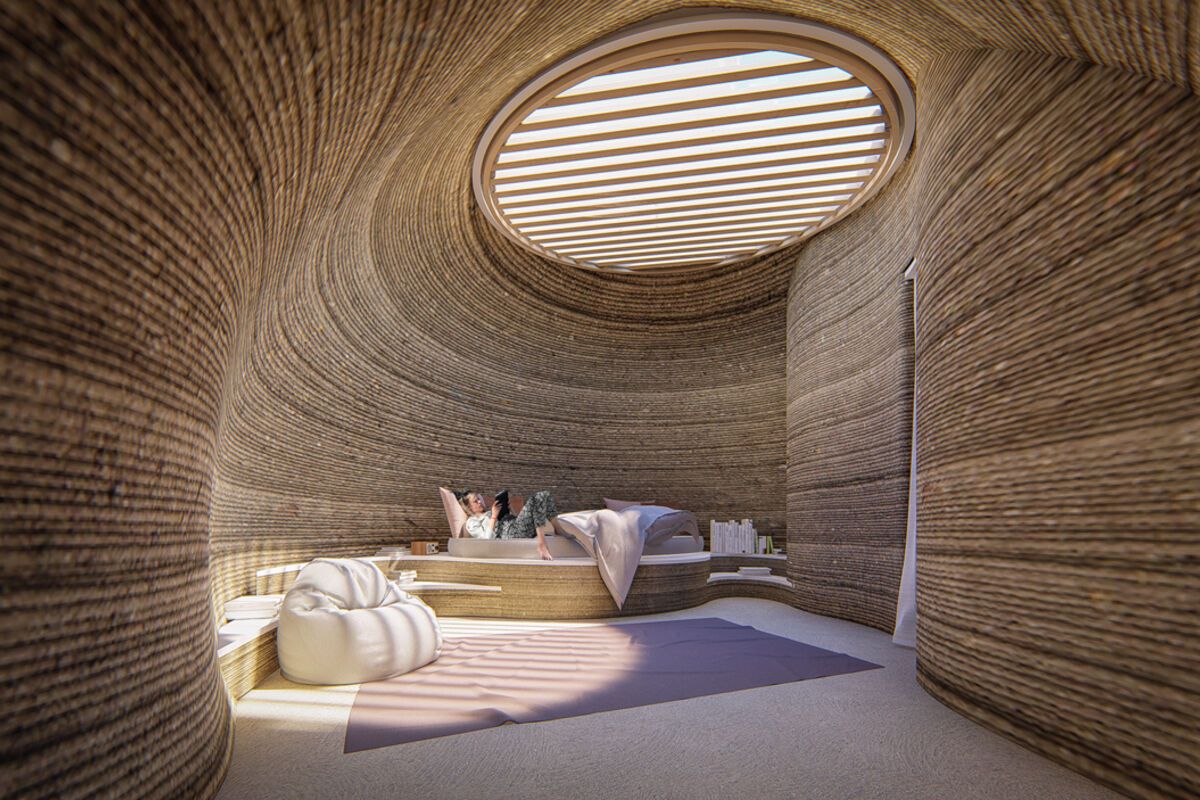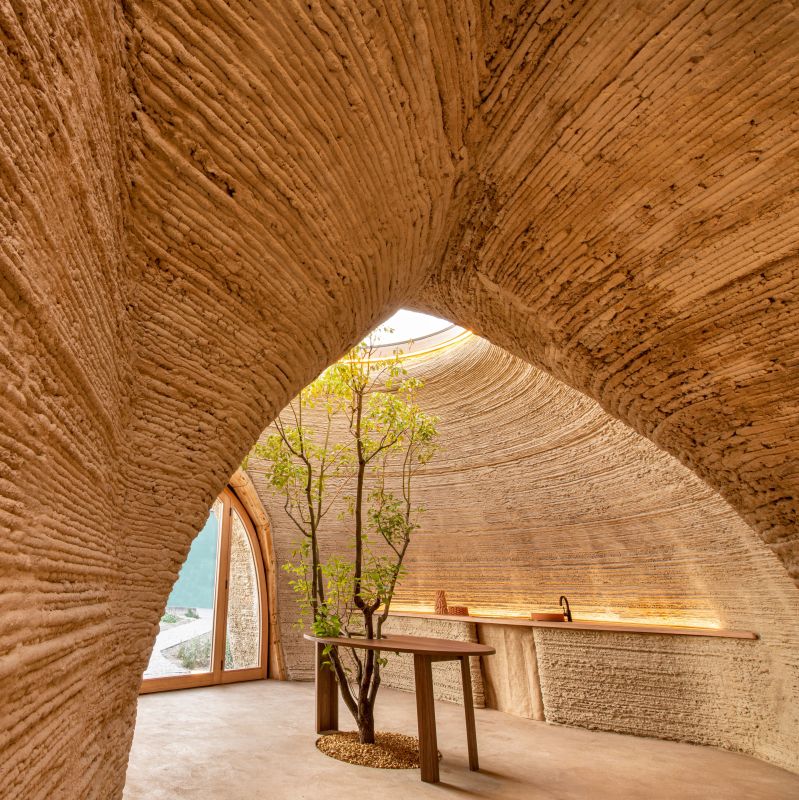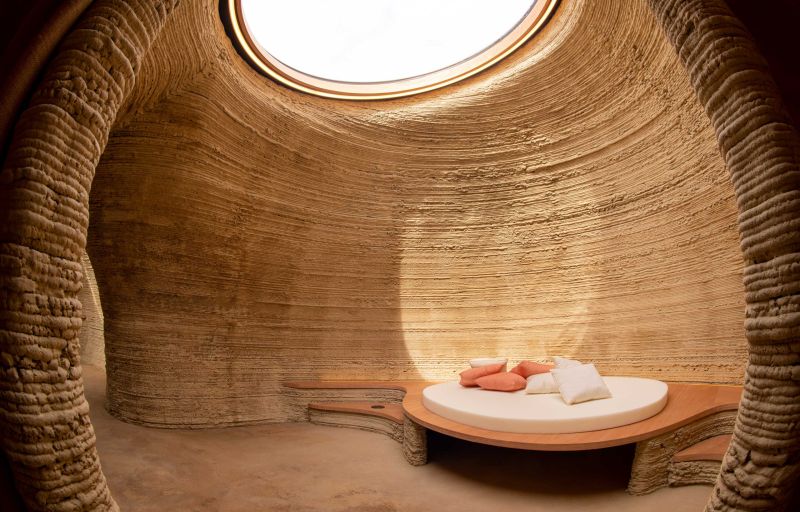
In just eight days, these homes rise from the ground as if by magic. Built with 3D printing technology using local soil, they combine cutting-edge robotics with eco-friendly principles. This approach provides an innovative, simple and elegant solution to today’s climate and social challenges.
They look like cocoons, settled on the ground as if they had naturally grown there. No straight lines, no concrete, just earth, carefully layered by two robotic arms moving with the grace of a choreographed dance. In 200 hours—barely eight days—an entire house takes shape. Printed on site using only natural materials. Its name? TECLA. Its mission? To transform how we inhabit the planet.
It all started in Italy, near Ravenna. WASP (World’s Advanced Saving Project), a company committed to eco-friendly 3D printing, teamed up with architect Mario Cucinella, renowned for his environmentally conscious designs. Together, they envisioned a house made entirely of raw earth, sourced directly on-site, without cement or heavy foundations. In 2021, TECLA became the first home printed solely using local soil resources, thanks to a fully automated system.
The concept is straightforward: two robotic arms, guided by software, apply earth mixed with plant fibers such as rice husks or hemp, layer by layer. Each layer is just 12 millimeters thick. The result? A well-insulated, 60-square-meter house that “breathes” and requires minimal energy to build—only six kilowatts.

The Tecla house, designed by architect Mario Cucinella. © DR
A Home Rooted in Nature
The inspiration comes from an insect: the potter wasp, which crafts its clay nest with remarkable precision. Drawing from this, Mario Cucinella designed TECLA. Its form echoes the soft, rounded shapes of clay nests, while also evoking traditional African dwellings and Gaudí’s curving architecture.
Technically, it’s a feat. The software controlling the robotic arms has around 7,000 lines of code. No need for concrete, nails or cranes. Raw earth transforms into a livable home with just a simple machine and a bit of electricity. “From shapeless earth to crafted home: today, we can build without harm, with a single click,” summarizes Cucinella.
But this project goes far beyond technology. It carries a strong social ambition. TECLA is designed to be replicable anywhere housing is scarce—in rural areas, impoverished regions or following natural disasters. The WASP system fits into a container, including printers, mixers and pumps. Once on site, all it takes is land and earth to start building.
A Vision for the Future
Using raw earth, an ancient yet often overlooked material, TECLA offers a third way between concrete, which is polluting, and wood, which frequently contributes to deforestation. This approach respects the planet while enabling fast, high-quality and affordable construction. There’s no need to ship expensive materials or depend on complex industrial supply chains. Just a machine and what the earth provides.
The challenge is huge: today, the construction sector accounts for nearly 40% of global greenhouse gas emissions. TECLA presents an alternative approach using local materials, cutting energy consumption, producing zero waste, naturally regulating temperature and offering genuine comfort. There’s also the design: no longer living in a box, but in a cocoon without sharp angles or rigid walls.

In just eight days, an entire house takes shape. © DR
Naturally, there are some limitations. These houses don’t exceed one story, as raw earth still can’t support greater heights. The installation of electricity, plumbing and windows remains a work in progress. But advancements are coming fast. Since TECLA, similar projects have taken root in Kenya, Spain and the United States.
For Mario Cucinella and WASP, the aim isn’t to build futuristic homes for the wealthy, but simple, dignified and durable housing for all, capable of withstanding climate and social crises. In this way, TECLA stands as clear proof that we can live differently and rely on the earth’s resources rather than exhaust them.
For those who, like turtles, carry their homes with them—slowly and with great effort—these lightweight, grounded habitats offer hope: dwellings with simple, poetic architecture that, above all, heal. We undoubtedly have much to learn from the animal world, which often cares more for its own than human societies do. Could the potter wasp, with its natural precision and ingenuity, be unknowingly lending a hand to the slow-moving turtle?

Comments